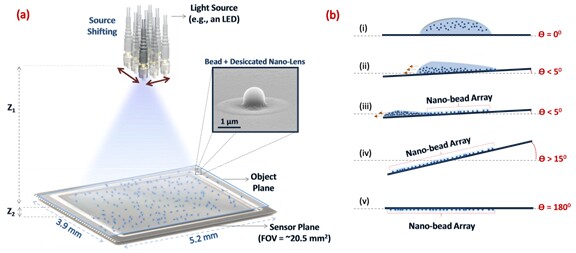To monitor their infection levels, people carrying chronic viral infections such as hepatitis and HIV need to get their viral load regularly checked. This measures how many viruses are present in a certain volume of blood or bodily fluid with current tests being expensive and needing to be done through laboratories. However, newly developed optical techniques being developed by two independent teams at the University of California could deliver cheaper and faster viral load tests that could be carried out in a medical office, hospital or even in the field.
One team, led by Aydogan Ozcan, an electrical engineer and bioengineer at the University of California, Los Angeles (UCLA), is working on a method that captures an image of single virus particles using holographic microscopy. This is done with the help of nanolenses that self-assemble around the virus particles and then work like tiny magnifying glasses, capturing optical images of nanoparticles and single viruses over an area as large as a postage stamp.
When a light is cast on the nanoparticle/nanolenses cluster, it projects a hologram that is recorded using a CMOS imager chip, like those found in digital cameras. Finally, by digitally manipulating the hologram, it can be reconstructed to form an optical image of the particle.

“Because viruses are very small – less than 100 billionths of a meter – compared to the wavelength of light, conventional light microscopy has difficulty producing an image due to weak scattering of sub-wavelength particles,” Ozcan says. “The resulting image improves the field-of-view of a conventional optical microscope by two orders of magnitude.”
This wider field of view means that one single photograph can contain images of a great number of nanoparticles, making it a good way to measure viral loads. As a commercial product, Ozan's team believes it could be translated into a compact, light-weight, mobile phone-attachment.
Meanwhile, a team led by Holger Schmidt, of the applied optics group at the University of California, Santa Cruz (UCSC), has taken a different route and developed a method whereby single particles are detected by tagging them with fluorescent labels on a microfluidic chip about the same size as a thumbnail. They are counted by detecting the genetic makeup of the viruses, also known nucleic acids. These are labeled with a fluorescent dye, and light from the resulting fluorescence is detected as they pass through a channel in the chip.
Schmidt’s research team says their labeling technique can target specific viruses and ignore the remaining, unlabeled material, which makes it a perfect fit for viral load tests since, in such cases, clinicians already know what they are looking for. They have succeeded in collecting reliable data on samples with dilution levels that fall within the range required for clinical detection.
Standard viral load tests use a technique called polymerase chain reaction (PCR), which amplifies a small sample of nucleic acid, such as DNA, to make it easier to be detected. In contrast, the new method counts real particles as they pass through the fluorescence detector on the chip housed in a small instrument measuring about one square foot, making it more mobile and potentially usable at the point of treatment.
Besides viral load tests, the researchers envisage other applications for their techniques, including detecting cancer bio-markers and carrying out environmental chemical analyses.
The teams will present their latest findings at the Conference on Lasers and Electro-Optics 2013, which will take place in San Jose, California between June 9 and 14.
Source: The Optical Society





